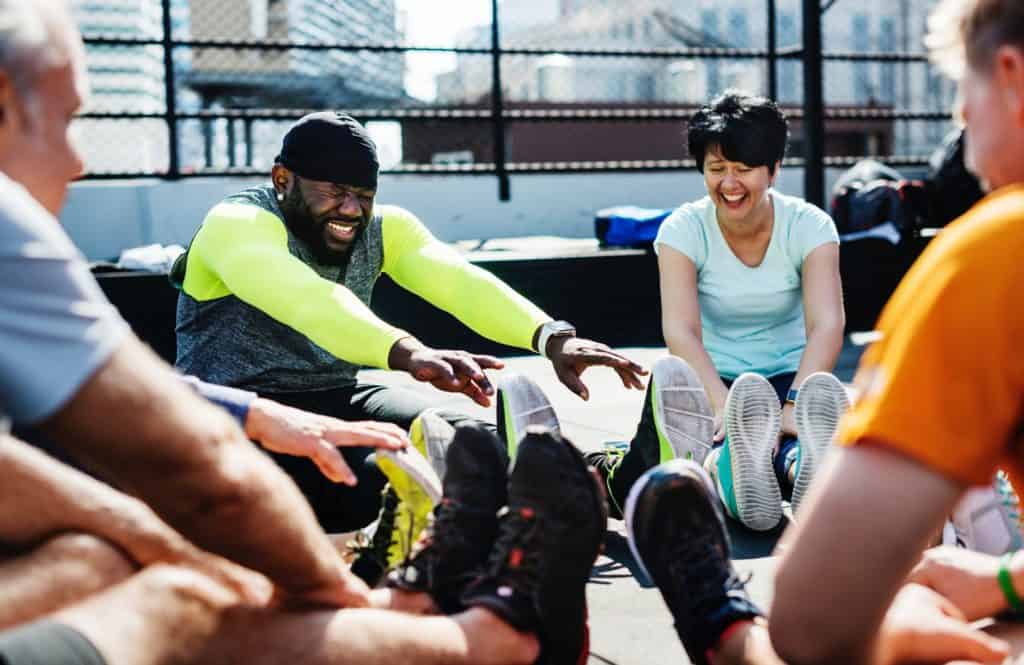How you workout after 30 needs to change (a bit)
I’ve been a personal trainer for years now, but have been in the gym even longer. I have have seen so many people make the mistake of not adjusting their workouts after turning 30. While I knew you need to swap some stuff up after various ages, until you experience it you cannot actually understand it entirely.
For example, there is the mental aspect of it. In your teens everything is good. Nothing hurts. You could go workout every day, then head off to practice for a few hours. You probably followed that up with a night out with friends. In your early to mid twenties you were in your peak. You had some extra cash (maybe), an established friend circle, and the gym was easy to crush. Keeping up with friends was easy because you all were equally active. Then you hit your thirties.
Some people kept up with the active life. Most tapered it off due to various commitments, careers, and life events. When I hit my thirties and started to feel it, that was quite an ego blow. I had been working out already and still had a tough time coming to grips with the mental changes. Regardless of if you are an active gym rat or just getting re-started back to better health in your thirties, know that I get it. The mental aspect is the hardest part, honestly. That part sucks.
Then there is the slower recovery time. At one point I could slam a few pizzas, down a 2L of soda, maybe have some sides, stay up until 3am, and still hit morning PT at 5am with my unit without much of an issue. If I tried that now I’d probably not be thrilled and my body would have some stern warnings for me.
There’s more
Throw in the more difficult progress due to the gradual decline of various hormones and the aging process as a whole, and you might feel like you are spinning your wheels and become demoralized to the point of quitting.
Instead of doing that, here are some ways your body changes as you get older, and how to change your workouts accordingly for best progress after 30 from someone with experience:
Start Slow and Build Up to New Exercises
If you’re not used to a certain exercise, start slowly. If you have never done a certain exercise, or at least not done it in a long time, go slow. Your body will need time to adjust and get used to the new activity. If it hurts, stop! Don’t try anything that causes actual pain. You’re better off taking a break than trying something that could end up making it worse.
Now, know the difference between actual pain and discomfort. You are in your thirties now. Discomfort is a thing that just happens. Pain is different. Pain is what you feel when you break a bone, rip a muscle, or tear a tendon/ligament. It’s something that comes from actual injury, from being very close to an injury, or generally doing too much and your body is telling you to stop.
Pain is NOT the same as discomfort. New movements, delayed onset muscle soreness (day after soreness), and other gym related issues are uncomfortable but do not inhibit you from movement.
If you’ve been doing the same workout routine for years and want a change of pace (or if you’re just bored), don’t jump into something new without easing yourself into it first.
Start with exercises that are similar in nature but slightly easier on the body. Instead of running full-out sprints at first, run at half speed. Jump on an elliptical machine for 20 minutes instead of burpees. You get the picture.
Use lighter weights the first time or two when targeting muscles your haven’t hit in a long time.
It’s the same game you play when you first start off at the gym. You just do it more gradually because of recovery time. The key is starting without hurting yourself.
Cut Back on Long Cardio Sessions
Too much static cardio can be damaging. Long distance running on the pavement can kill your joints, especially if you are a consistent long distance runner (more than a few miles more than a few times a week). The constant impact on your knees and hips can start to wear them out. In our thirties we need to start thinking about preserving and strengthening what we have so we can set ourselves up for success in our 40s and beyond.
Regardless of if you are a new runner or a seasoned distance champ, think about substituting some of the long distance for high intensity interval training, or HIIT.
10-20 minutes of HIIT will get you the same, or better, results than road running will. And without the constant stress on your joints of running 5/10/20+ miles at a time!
Trust me, your knees will thank you. This is an easy, and usually quite happily made change in workouts after 30.
Focus On Lifting Weights
Lifting weights is a great way to maintain muscle mass and bone density as you get older. It also helps burn more fat, which can help you stay strong and active as you age.
Lifting weights helps improve metabolism due to the increased muscle mass. It can boost your mood thanks to the endorphins it releases, which, lets face it, is never a bad thing.
Plus, it increases bone density and strength which is enormous as we age. Women over 30 start to drastically increase their risk of osteoporosis as they age. Resistance training can help reduce that potential quite a bit.
Other awesome benefits are that weights improve balance and coordination (which is especially important as we age), and a reduction in the risk of diabetes and heart disease. And that’s just scratching the surface!
If you’re new to lifting weights or haven’t lifted in awhile, go slow and ask questions.
Need some help?
Shape Success, Live Exceptionally
Hit that button, and get started today.
Be Prepared for Injuries and Add In Recovery Time
Maybe you are used to going hard at the gym, but your body probably won’t be able to keep up with the same intensity as it did in your 20s. You’ll need to make some adjustments and changes in how you workout after 30 if you want to stay healthy and avoid injuries.
For starters, be prepared for injuries to occur.
As we age, our bodies become less resilient and more prone to injury. If a workout causes pain or soreness that lasts longer than a couple days, give it the time it needs! If the pain is sharp or severe (like an acute sprain), see a doctor immediately as this could be sign of something more serious. Things like tendonitis or ligament damage require professional attention before it becomes chronic.
If anything feels off during exercise (a twinge in your knee while running) take note of it. Should it go away, great. If it doesn’t, take the appropriate action.
Knowing that your chances of injury increase as time goes by (as does your recovery time) is something that should be taken into account. Plan for it by adding in a bit more recovery time where you need. Maybe put an extra day in between workouts or move recovery periods between sets from 30-45 seconds up to a minute. Don’t go so hard that you cannot continue and listen to what your body is telling you.
Set Goals and Follow a Plan to Keep You Motivated
Setting goals and following a plan to keep you motivated is one of the best things you can do. If you’re not sure where to begin, start by defining your goals before you begin working out. Your goals should be realistic and attainable–if they aren’t, then they won’t motivate you to stay on track.
Setting time frames for these new fitness habits is also key; instead of just saying “I will lose weight,” set an exact date by which this goal will be achieved (for example: Lose 15 pounds within six months). Keep in mind that setting tangible fitness goals with specific measurements such as inches lost or pounds shed can help keep motivation high!
Listen To Your Body
As you get older, your body will change. If a workout feels too hard or if something hurts, stop doing it. Take a rest day if you need one–you’ll be better off in the long run if you listen to what your body is telling you.
Your muscles need time to repair themselves after being put under stress during exercise. Otherwise, they’ll suffer from overuse injuries like tendonitis or tendinosis (which only gets worse with age).
If getting enough sleep is an issue for any reason, consider cutting back on other activities so that there’s room for restorative sleep every night without fail! Not saying you should cut out bowling night, but if you stay up watching Netflix for hours maybe cut back a bit.
Consider a Personal Trainer
When you’re over 30, the best way to get in shape isn’t always going to be the same as when you were younger. This is especially true because there are certain things that happen as we age that can affect our bodies in ways that make it more difficult for us to exercise effectively and safely. For example:
- Our joints become less flexible (and therefore more susceptible to injury) as we age.
- Our metabolism slows down as well.
- We have less energy than we did when we were younger due to a decrease in muscle mass and fat stores.
All of these things mean that if your workout routine hasn’t changed since high school or college, then chances are very good that it needs some tweaking now! If you need some help building out a new plan, consider hiring some help and I don’t mean the 18 year old kid that works at Planet Fitness. Find someone with experience in your shoes. That younger gym trainer might know about building a plan, but they don’t always have the experience to deal with slightly older folks and build according to their needs.
It’s important to change your workouts as you get older, starting after 30.
As you get older, your body changes and so does the way you exercise. Be aware of these changes and make the necessary adjustments to keep yourself from getting hurt.
If you’re over the age of 30, it’s important to change your workouts as you get older. You’ll need to focus more on strength training and cut back on long cardio sessions. Start slow and build up to new exercises, being prepared for injuries along the way. A personal trainer can help ensure that your program is safe and effective, while also keeping you motivated with regular check-ins and goals.
It’s important not to push yourself too hard because doing so could lead to injury or burnout.
Let Us help You Out
At CONDITIONerd we are here to help you achieve better physical and mental health through exercise. Check out the plans we offer to our customers and see if you could benefit from working with our team. And if you have questions, you can always contact a CONDITIONerd team member.
Personal trainers, like those found here, can help guide you on your pathway towards reaching your fitness goals, whether that is getting bigger, stronger, faster, more lean, or just generally feeling better.
We can get you setup with a periodized workout plan, supplement information, and advice on nutrition to help you reach your goals.
The only thing you need is some motivation and a willingness to change some old habits.

